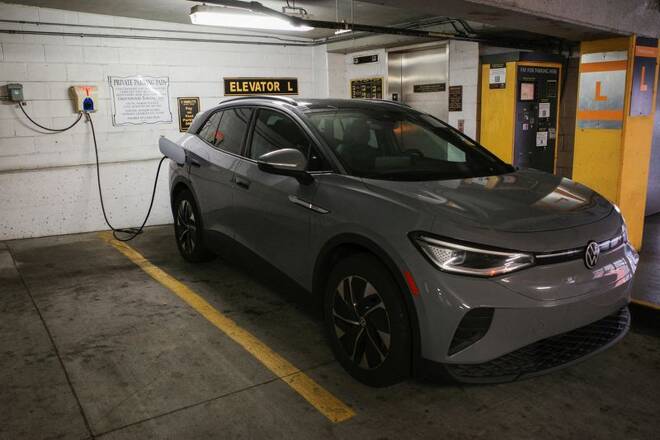Advertisement
Advertisement
Factbox-How U.S. electric vehicle subsidy rules impact Europe
By:
BRUSSELS (Reuters) - The U.S. Treasury Department is expected to give guidance on Friday on tax breaks for consumers buying electric vehicles and Europe's auto sector and policymakers will be closely watching to assess the consequences for European industry.
BRUSSELS (Reuters) – The U.S. Treasury Department is expected to give guidance on Friday on tax breaks for consumers buying electric vehicles and Europe’s auto sector and policymakers will be closely watching to assess the consequences for European industry.
Made in america conditions
The Treasury is not expected to specify vehicle models but merely lay out the subsidy criteria.
Under the Inflation Reduction Act (IRA), U.S. consumers buying electric vehicles qualify for a tax credit of $7,500 as long as final assembly is in North America. Half of the credit depends on 50% of the value of battery components being produced in North America, the other half if 40% of the value critical minerals are from the United States or a country with which it has a free trade agreement. These shares rise by 10 percentage points per year.
Eu auto sector strength
The European Union exported some 36 billion euros ($39 billion) of cars to the United States in 2022, according to Eurostat, some 65% from Germany, with less than 9 billion euros worth of cars coming the other way.
The EU also exported about 9 billion euros of car parts to the United States, compared with 2 billion euros of imports.
The trade in car parts in particular is often intra-firm or related party trade, reflecting integrated transatlantic supply chains.
The car industry supports more than 12 million direct and indirect EU jobs, according to EU automakers group ACEA.
Detailed guidance
The EU auto industry and policymakers will be keen to see whether the terms “final assembly” and “battery components”, are defined broadly or in a narrow way.
For example, EU trade officials are wondering whether the local content requirement for battery components means just specific components or all components and how comprehensive final assembly must be.
BusinessEurope confederation deputy director general and trade expert Luisa Santos said it was important to see if any of the IRA’s discriminatory elements had been addressed, to confirm leased vehicles would be exempt from local content requirements and to see if there would be any transition periods.
“The IRA threatens to disrupt existing supply chains, which have a lot of synergies. It is putting into question the transatlantic model businesses have built with investments that support trade on both sides of the Atlantic,” she said.
Lease cars exemption
Treasury guidance in December allowed electric vehicles assembled outside North America to qualify for tax credits if they are leased by consumers.
Leasing of electric vehicles dropped from just over 50% in 2020 to around 12% in the first nine months of 2022, according to data from the U.S. National Auto Dealers Association, which excludes Tesla numbers as it is not an NADA member.
The decline is partly due related to the COVID-19 pandemic and related disruption of supply chains, leading consumers to retain more cars at the end of their leases. It is unclear to what extent that trend might reverse as supply chains normalise.
Some in the EU industry express concern that a change of U.S. president could see this lease car concession end.
Critical minerals deal?
Washington and Brussels agreed this month to discuss allowing companies to supply critical minerals extracted or processed in the European Union even though the two sides do not have a free trade agreement.
Initial indications are that a deal would cover five minerals – cobalt, graphite, lithium, manganese and nickel.
EU to U.S. exports of those five materials doubled in 2022 from a year earlier, but were still only worth 15 million euros, according to data from European statistics office Eurostat.
The EU is pushing to expand its extraction and processing of critical raw materials, but it likely to remain a net importer and it is not clear if it will ever have a surplus to export for use in U.S. vehicles.
Eu industry view
Mercedes said that while it supports the aim of decarbonising transport, the U.S. incentives were linked to conditions that significantly limit the scope and pose challenges for it as a manufacturer and it is reviewing the impact of the IRA on its suppliers and own U.S. production.
Volkswagen has said it is awaiting Europe’s response to the IRA before progressing with plans to build more battery plants in Europe.
($1 = 0.9223 euros)
(Reporting by Philip Blenkinsop; editing by Robert Birsel)
About the Author
Reuterscontributor
Reuters, the news and media division of Thomson Reuters, is the world’s largest international multimedia news provider reaching more than one billion people every day. Reuters provides trusted business, financial, national, and international news to professionals via Thomson Reuters desktops, the world's media organizations, and directly to consumers at Reuters.com and via Reuters TV. Learn more about Thomson Reuters products:
Latest news and analysis
Advertisement
